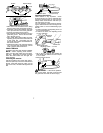
5
Small Radius Tip
Reduced Kickback Symmetrical Guide Bar
Symmetrical Guide Bar
Large Radius Tip
S
Low--Kickback Chain, designed with a
contoured depth gauge and guard link
which deflect kickback force and allow
wood to gradually ride into the cutter.Low--
Kickback Chain has met kickback per-
formance requirements when tested on a
representative sample of chain saws be-
low 3.8 cubic inch displacement specified
in ANSI B175.1.
Low---Kickback
Chain
Not a Low---Kickback Chain
Can Obstruct Material
Contoured Depth Gauge
Elongated Guard Link
Deflects
kickback force
and allows wood
to gradually ride
into cutter
S
Front Hand Guard, designed to reduce the
chance of your left hand contacting the
chain if your hand slips off the front handle-
bar.
S
Position of front and rear handlebars, de-
signed with distance between handl es and
“in-line” with each other. The spread and
“in-line” position o f the hands provided by
this design work together to give balance
and resistance in controlling the pivot of
the saw back toward the operator if kick-
back occurs.
CHAIN BRAKE AND CKA ANGLE
S
Chain Brake, designed to stop the chain in
the event of kickback.
WARNING:
WE DO NOT REP-
RESENT AND YOU SHOULD NOT AS-
SUME THAT THE CHAIN BRAKE WILL
PROTECT YOU IN THE EVENT OF A
KICKBACK. Kickback is a lightning fast ac-
tion which throws the bar and rotating chain
back and up toward the operator. Kickback
can be caused by allowing contact of the bar
tip in the danger zone with any hard object.
Kickback canalso be caused by pinching the
saw chain along the top of the guide bar. This
action may push the gui de bar rapidly back
toward the operator. Either of these events
may cause you to lose control of the saw
which could result i n serious injury or even
death. DO NOT REL Y UPON ANY OF THE
DEVICES BUILT INTO YOUR SAW. YOU
SHOULD USE THE SAW PROPERLY AND
CAREFULLY TO AVOID KICKBACK. Re-
duced--kickback guide bars and low--kick-
back saw chains reduce the chance and
magnitude of kickback and are recom-
mended. Your saw has a low kickback chain
and bar as original equipment. Repairs on a
chain brake should be made by an autho-
rized servicing dealer. Take your unit to the
place of purchase if purchased from a ser-
vicing dealer, or to the nearest authorized
master service dealer.
S
Tipcontact insome cases maycause alight-
ning fast reverse REACTION, kicking guide
bar up and back toward operator.
S
Pinching the s aw chain along t he top of the
guide bar may push the guide bar rapidly
back tow ar d the operator.
S
Either of these reactions may cause you to
lose control of the saw which could result in
serious injury . D o not rely exclusively upon
devices built i nto your saw.
WARNING:
Computed kickback
angle (CKA) listed on yoursaw andlisted inthe
CKA table below represents angle of kickback
your bar and chain combinations will have
when tested in accor dance w ith CSA (Cana-
dian Standards Association) and AN SI stan-
dards. When purchasing replacement bar and
chain, considerations should be given to the
lower CKA values. Lower C KA values repre-
sent safer angles to the user, higher values in-
dicate more angle and higher kick energies.
Computed angles represented indicate total
energy and angle associated without activation
of the chain brake during kickback. Activated
angle repr esentschain stopping time relative to
activation angle of chain break and r esulting
kick angle of saw. In all cases lower CKA v al-
ues r epr esent a safer operating envir onment
for the user.
The following guide bar and chain combina-
tions meet kickback requirements of CSA
Standards Z62.1, Z62.3, & ANSI B175.1
when used on saws listed in this manual.
Use of bar and chain combinations other
than those listed is not recommended and
may not meet the CKA requirements per
standard.
Computed kickback angle (CKA) Table
BAR
P/N Length CHAIN P/N
952044366 12! 952051208
MODEL
CKA without chain brake
1900
4
_


















